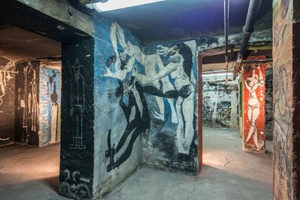Kosmos Blauer Reiter. Von Kandinsky bis Campendonk
In the organizer's words:
The Berlin Kupferstichkabinett has an outstanding collection of modern art, such as the holdings of works by Edvard Munch, Käthe Kollwitz and Ernst Ludwig Kirchner. It is hardly known that the artists of the Blaue Reiter also left more than remarkable traces. For the first time, the Kupferstichkabinett is therefore dedicating a comprehensive exhibition to the art of the Blue Rider and is presenting the museum's Blue Rider holdings on the basis of 90 works under thematic aspects. Selected works on loan from the Art Library, the Museum of European Cultures and the New National Gallery of the National Museums in Berlin as well as from private collections in Berlin will also be on display.
The Blue Rider
Der Blaue Reiter was founded in Munich in 1911 by Franz Marc and Wassily Kandinsky as an editorial partnership. The project gained profile in the form of two exhibitions and an almanac of the same name (published in 1912). With the beginning of the First World War in 1914, most of the activities of the Blauer Reiter, which was not a permanent association, came to an abrupt end. Kandinsky had to leave Germany, August Macke and Franz Marc were killed in action in 1914 and 1916.
Abstraction and stylistic diversity
At the heart of Kandinsky and Marc's ideas was the creation of works that made the spiritual visible through inner artistic experience. This led Kandinsky in particular to liberate color and form from the concrete reference to objects - and thus to the path to abstraction.
As the example of August Macke shows, there were clear stylistic differences, especially as the Blaue Reiter engaged with the then current painting and graphic art in Europe and invited numerous artists to exhibitions. In the search for creative potential and the "spiritual in art" (Kandinsky), products of religious folk art such as votive tablets and reverse glass paintings gained a new appreciation. Russian picture sheets from the 19th century even became exhibition exhibits.
Art on paper
The fact that not only painting but also drawing and printmaking played an important role in Der Blaue Reiter is demonstrated by the second exhibition "Der Blaue Reiter. Black and White". André Derain, Natalia Goncharova, Mikhail Larionov, Ernst Ludwig Kirchner and Emil Nolde were among the artists taking part, who - unlike Gabriele Münter, Alfred Kubin and Paul Klee, for example - did not belong to the inner Munich circle of the Blue Rider.
A tour in seven chapters
In seven chapters, "Kosmos Blauer Reiter" is dedicated to the prints of Wassily Kandinsky, the painterly works on paper by August Macke and Franz Marc's preoccupation with animals and nature. The poetic pictorial correspondence between Franz Marc and the poet Else Lasker-Schüler is honored, as is the question of the female artists in the Blue Rider.
One chapter sheds light on the many facets of the pictorial world of the almanac "Der Blaue Reiter" and the "Schwarz-Weiß" exhibition, before concluding with a look at the Berlin avant-garde gallery "Der Sturm". It opened in 1912 with an exhibition by Der Blaue Reiter and Oskar Kokoschka. Heinrich Campendonk was prominently represented with woodcuts in the magazine of the same name.
Artists in the exhibition
Hans Baldung, Heinrich Campendonk, Daniela Comani, Jutta Damme, André Derain, Robert Delaunay, August Gaul, Natalja Goncharova, Jacoba van Heemskerck, Bernd Koberling, Wilhelm Kuhnert, Alexej von Jawlensky, Wassily Kandinsky, Ernst Ludwig Kirchner, Paul Klee, Oskar Kokoschka, Alfred Kubin, Else Lasker-Schüler, Michail Larionow, August Macke, Franz Marc, Wilhelm Morgner, Gabriele Münter, Emil Nolde, Max Pechstein and Heinrich Rambold.
Exhibition catalog
The exhibition is accompanied by a richly illustrated book (112 pages).
Curatorial team
The exhibition is curated by Andreas Schalhorn, curator of modern art at the Kupferstichkabinett, in collaboration with Claudia Lojak, research assistant at the Kupferstichkabinett.
Media cooperation: tipBerlin
A special exhibition of the Kupferstichkabinett - Staatliche Museen zu Berlin
This content has been machine translated.Price information:
Admission: 8.00 EUR, reduced 4.00 EUR. Free admission for children and young people up to and including the age of 18.













